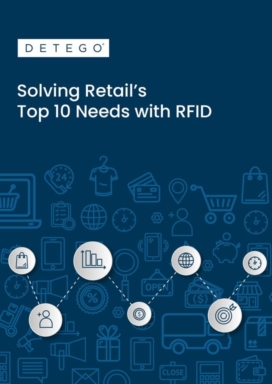The retail environment has never been more demanding than it is today, thanks to fierce competition, the growth of e-commerce, and consumers’ high expectations for seamless shopping experiences. It’s a situation made even more difficult by a lack of inventory visibility, the complexity of supply chains and the sheer variety of products brands are faced with.
While retailers have access to a growing number of solutions to these issues, RFID (Radio Frequency Identification) is the only one that’s proven to consistently meet retailers’ needs for leaner processes, accurate inventory and real-time data analytics.
This webinar covers:
• The five most important needs identified by retailers and their effect on business
• How RFID-based systems and processes can be applied to solve each need
• What financial and operational benefits can be gained by doing so
• How retailers can further unlock the power of RFID to offer a truly seamless and connected shopping experience
The 6 Key Benefits of RFID in Retail
RFID (Radio Frequency Identification) uses radio waves to track and identify tags attached to objects. The tags contain electronically stored information and are counted or ‘read’ by either handheld or fixed RFID readers.
In many ways RFID is used in retail as an alternative to a barcode system (although it doesn’t have to replace barcodes entirely). The more advanced technology involved in RFID mean it has a far greater level of accuracy and efficiency when it comes to counting inventory. As a result of this it has far broader applications in retail, most of which are built of off the back of this reliable inventory visibility.
By implementing RFID retailers can on average increase their revenue from 5-15% depending on the business. This on top of a margin increase of up to 1% and 10-15% lower working capital due to optimised inventory levels.
According to research in 2018, 69% of retailers cite a significant level of adoption, and this number is continuing to rise.

eBook
Solving Retail's Top 10 Needs with RFID
Discover how retail RFID is changing the industry for good. This eBook will guide you through the top 10 needs identified by retailers to ensure sustainable success in the modern environment. Explore the common challenges preventing retailers from achieving their goals and learn how applying smart RFID-based solutions delivers consistently good results.
Inventory Visibility

Due to the ease and accuracy of RFID stock counts, retailers using the technology can reliably achieve full item-level inventory visibility across their stores and supply chains. Crucially, due to the speed of RFID inventory counts, this can be achieved whilst actively reducing the labour intensity of operational processes. This accurate and up-to-the-minute inventory information is the backbone of so many of RFID’s uses in retail (including many of the points discussed below).
One crucial aspect of modern retail that relies on having accurate inventory visibility is Omnichannel retailing. With a complete and up-to-date view of stock across all channels, it is possible to open up the inventory of your entire store network to customers, providing a better customer experience and increasing sales.
Benefits of item-level inventory visibility
- Improved shipping accuracy
- Excellent baseline for advanced omnichannel retailing
- Produces more data for better insights
- Reduces inventory size (and therefore working capital) significantly
- Increased customer satisfaction from reduced out-of-stocks and a more connected experience
Increasing Product Availability

Ensuring a high product availability is vital to maintaining retail sales. Despite this, low on-floor product availability and out-of-stocks are an alarmingly common problem in the industry, causing unnecessary lost sales as a result of inefficient replenishment processes and stock inaccuracy. This latter cause is practically removed completely by RFID, with typical stock accuracy being increased to 99% from the standard 60-80%.
Additionally, RFID platforms provide an unbeatable basis for efficient and reliable replenishment processes. The main advantage these platforms have is the item-level and real-time inventory visibility gained from regular 99% accuracy stock counts.
How does RFID increase product availability?
- Makes regular cycle counts possible with efficient RFID stock reads
- Removes stock inaccuracy (from 70-80% to 99%)
- Creates complete item-level view of stock between both backroom and sales floor
- Item visibility makes replenishment easier and more accurate
- Real-time view allows for replenishment alerts for when items/sizes are running low
- Item-level data from RFID allows for advanced, even AI-assisted planograms for individual stores
Supply Chain Traceability

We’ve discussed the difference item-level visibility makes for stores, but when it comes to supply chains the benefits are just as great. With RFID, inbound and outbound reads become far easier, and are done on an individual item level rather than SKU (stock keeping unit). This means each item is accounted for at each step of the supply chain, rather than just shipments or boxes.
This level of stock visibility also drastically reduces the rate of shipping errors or picking mistakes as they are detected by RFID readers and corrected by warehouse staff during exception handling or outbound reads.
Additionally, the location or status of items and shipments are visible in real-time, so stores and DC’s can easily track shipments and know exactly what they will be receiving. This makes any individual item fully traceable, as time and dates of when the item passed each read point in the supply process can be stored.
Benefits of RFID in the supply chain:
- Item-level visibility across entire supply chain
- Trace items against individual shipments
- Smoother operational processes
- Track shipments for delivery
- 100% inbound and outbound shipping accuracy
Increasing Process Efficiency

The difference in process efficiency from using RFID in retail is extensive, at every end of retail, be it the factory or the shop floor. An RFID reader, regardless of whether its fixed or a handheld, can read hundreds of individual items at once. Crucially though, as each item has a unique ID, they can never be read more than once. The signals also do not require line of sight to be read.
Naturally, this makes RFID inventory counts and inbound/outbound checks incredibly fast and reliable. In the case of store inventories, RFID has been found to reduce cycle count times by a staggering 96%. This therefore means they are far more convenient to perform and can be done multiple times in a week rather than a year.
Processes transformed by RFID:
- Cycle counts/inventories
- Fast & Efficient Inbound & Outbound reads
- RFID-enabled picking and packing
- Mobile guided replenishment from backroom to salesfloor
Providing Real-Time Data

Analytics and data is one area that e-commerce is ahead of physical retail. This is largely due to the fact that everything online can be measured, whereas retailers don’t really know what’s happening with their stores and customers in any specific detail, and the stats and data they do collect are often historical and at risk of being outdated.
However, with RFID this can all change. The simplest and most effective use of the data allows retailers to better leverage their greatest assets; their products and their stores. Quality data and analytics can allow retailers to ensure merchandise is in the right place to be sold. Information on which stores are performing better or worse is a basic retail KPI, but with specific item data, RFID produces far more detailed insights. This includes how well individual items are doing in specific stores, right down to specifics such as which sizes of items are selling better where. Insights such as these are naturally actionable, meaning retailers can take steps to move or reinforce stock at specific stores.
Data insights and results possible with RFID:
- KPI based performance tracking
- Detailed merchandise data & Analytics
- Operational excellence
- Actionable recommendations
- Compliance tracking
- Eliminates reliance on historical data
- Predictive capabilities for inventory counts and merchandise management
Transforming Customer Experience

There are many effects of RFID in retail that go beyond simple operational benefits to actively improve the customer experience. At the most basic level, this includes things already mentioned like increasing product availability, offering convenient omnichannel services and freeing up store associates to spend more time assisting customers.
However, because of the real-time inventory visibility it provides, RFID can go way beyond this in terms of improving the customer experience. For example, with reliable and up-to-the-minute stock information stores can utilise technologies like chatbots or smart fitting rooms to assist customers with their queries, supply information about other items or sizes available and even cross-sell to customers in the store.
What ways does RFID improve the customer experience?
- High product availability
- Store associates have more time for their customers
- Convenient omnichannel services
- A connected experience between online and offline
- AI-powered chatbots delivering assistance and product information via mobile.
- Smart fitting rooms providing a hugely improved fitting room experience.
- RFID-enabled Point of Sale – including self-checkout services

eBook
Solving Retail's Top 10 Needs with RFID
Discover how retail RFID is changing the industry for good. This eBook will guide you through the top 10 needs identified by retailers to ensure sustainable success in the modern environment. Explore the common challenges preventing retailers from achieving their goals and learn how applying smart RFID-based solutions delivers consistently good results.
99% Stock accuracy
98.5% product availability
750+ stores
2000+ sales employees trained
An extraordinary four-month project sprint for 500 adidas stores in Russia has been successfully completed. The goal: Boost store KPIs such as inventory accuracy, article availability and consumer service to the highest levels. The means to achieve that: Extremely fast, error-free stock taking of 45 million articles per year through real-time in-store processes that are more efficient and intuitively managed, using decision-relevant analytics. The end-to-end integration was accomplished in just four months. The interdisciplinary project team consisted of business, IT, logistics and retail experts coming from five different countries – all working together across ten different time zones. The result: 99% inventory accuracy and the highest on-floor availability that adidas wanted for its stores. The winner: The adidas end customer.
The future? Athletic.
Customers drive retail strategies with their various and versatile demands. They want the ability to shop anytime, anywhere while expecting a consistent brand experience in the store, on the web and using mobile apps. Customers anticipate immediate access on an article’s availability across all channels – and fast delivery! Failure means losing a customer to a competitor. They’re only a click away. Meeting these expectations requires a digital transformation of the stores and efficient omni-channel retailing. But how to implement these strategies successfully? With an intelligent business base.
The implementation of an omni-channel strategy is a major undertaking. Regardless of whether your company is just at the starting point, in the middle of the project implementation, or already in a more advanced stage, if the foundation for omni-channel retailing is not well laid, the project is doomed to fail. This whitepaper provides 5-basics-checks for the fundamentals of efficient omni-channel retailing. It helps to build a solid foundation for a successful implementation of omni-channel retailing – regardless of the stage your company has already reached in the realisation of its omni-channel strategy. It is aimed to reach practitioners responsible for the omni-channel initiative and therefore those with clear expectations on the cost-benefit aspects of any omni-channel investment. It provides C-levels, Omni-channel-, eCommerce- and Marketing Executives with reflective and feasible recommendations for actions to take for more efficient omni-channel retailing. The Whitepaper focuses on the following omni-channel-services, expected by consumers: availability checks, click & collect, ship-from-store, return-to-store and instore-ordering.



